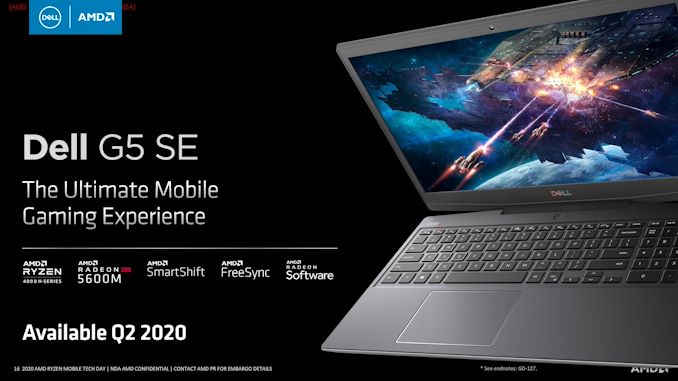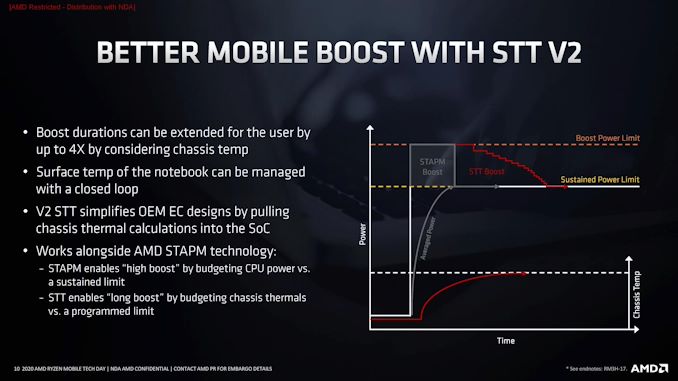AMD Details Renoir: The Ryzen Mobile 4000 Series 7nm APU Uncovered
by Dr. Ian Cutress on March 16, 2020 11:00 AM ESTAMD SmartShift
We’ve covered AMD’s SmartShift before, when it was announced at CES, as a technology that allows a system management controller to interact with both the mobile APU and an AMD graphics card in the same system in order to shift power where it is needed. This solution is still based on separate power rails between the two, however the use of the scalable control fabric (SCF) part of Infinity Fabric means that parts of the APU and parts of the GPU can interact together in this way. Ultimately AMD believes they can score 10-12% better on heavy CPU workloads like CineBench or gaming workloads like The Division.
The solution is firmware based, but requires interaction between qualified hardware. AMD states that often in these sorts of CPU+GPU designs, while the chassis has a total design TDP, if one of the elements of the system is idle, then the other can’t take advantage of the extra turbo headroom available. SmartShift aims to fix that.
What’s new here is that AMD is primarily focus will be on Ryzen Mobile 4000 + Vega 10 style systems. The first one with SmartShift enabled will be the Dell G5 SE. The Dell G5 SE is being labelled as ‘the ultimate mobile gaming experience’, and will feature a new H-series processor, the Radeon RX 5600M, SmartShift, FreeSync, and have a 15-inch display. The unit will be coming out in Q2.
System Temperature Tracking (Version 2)
SmartShift is also part of a new System Temperature Tracking paradigm that AMD is implementing in its new APUs. Even if there is power headroom, a system can’t turbo if there isn’t thermal headroom. Smart Temperature Tracing v2 (or STTv2) is designed to help a system boost for longer by knowing more about the thermal profile of the device.
My placing additional thermal probes inside the system, such as on hot controllers or discrete GPUs, the readings of these can be passed through the Infinity Fabric to an embedded management controller. Through learning how the system thermals interact when different elements are loaded, the controller can determine if the system still has headroom to stay in turbo for longer than the current methodology (AMD’s Skin Temperature Aware Power Management). This means that rather than having a small number of sensors getting a single number for the temerpature of the system, AMD takes in many more values to evaluate a thermal profile of what areas of the system are affected at what point.
What STTv2 does at the end of the day is potentially extend the boost time for a given system, depending on its thermal capabilities. For example, the Lenovo Yoga Slim 7 which we are expecting for review only has a 15 W processor inside, but the chassis has been built for a 25 W TDP design, which means that STTv2 should kick in and provide the user with peak performance for longer.














95 Comments
View All Comments
watzupken - Tuesday, March 17, 2020 - link
To this point,"Renoir has a huge range of load vs. power consumption: Please, please, PLEASE ensure that in all form factors users can make a choice of power consumption vs. battery life or cooling by setting max and sustained Wattage preferably at run-time and not hard-wiring this into distinct SKUs. I’d want a 15 Watt ultrabook to sustain a 35 Watt workload screaming its head off, just like I’d like a 90 Watt desktop or a 60 Watt NUC to calm down to 45/35/25 Watt sustained for night-long batches in the living room or bed-side—if that’s what suits my needs: It’s not a matter of technology, just a matter of ‘product placement’."
I doubt they will ever let you do that on a laptop or even NUC officially. The cooling solution implemented is usually very closely correlated to the TDP of the processor. Even when it is a downgrade from say a 45W to 35W, these are usually tightly controlled by AMD and Intel. There is no guarantee that all chips will work well at a certain clockspeed across various TDP. For example, a Ryzen 7 4800H may not be able to run at a 4800U speed when you reduce the TDP from 45W to 15W. U series chips are binned to be able to run at that the specific clockspeed and likely also commands a higher premium.
Tams80 - Tuesday, March 17, 2020 - link
This. If you want to push your system, with the risk of damaging it, then you should be free to as long as there's no direct risk of it causing harm.Namisecond - Thursday, March 26, 2020 - link
Why are you using a laptop for a workstation task? If you have to hide it in a closet, then you really don't get to choose the where and when. Might as well rent out some hardware at a data center and do the work remotely. Not judging, just saying your way of doing things doesn't make a whole lot of sense to me.yankeeDDL - Tuesday, March 17, 2020 - link
I have a question: let's take Ryzen 7 4800U and Ryzen 3 4300U devices.Both are 15W parts, yet, one has 4/4 C/T and the other 8/16.
The 4300U has less GPU CU and lower clock.
How can they have the same TDP? Does this mean that the 4300U is likely to stay at Turbo a lot more consistently than the 4800U?
Spunjji - Tuesday, March 17, 2020 - link
Possibly. It will more likely mean (at least initially) that the 4300U is an inferior specimen and needs more voltage to reach its standard clock speeds.yankeeDDL - Tuesday, March 17, 2020 - link
It's possible. I guess also that's why they can increase the base clock on lower core count.djayjp - Tuesday, March 17, 2020 - link
AMD: "Making the best graphics engine even better -- Vega 7nm" Surely they mean Navi...? Confused.yankeeDDL - Tuesday, March 17, 2020 - link
No, it is Vega architecture, ported to 7nm. With some improvements (as described in the article itself), but it is still Vega.djayjp - Wednesday, March 18, 2020 - link
Right I get that but surely Navi is a better architecture than Vega (look at Radeon VII vs 5700 XT).djayjp - Wednesday, March 18, 2020 - link
Especially for mobile